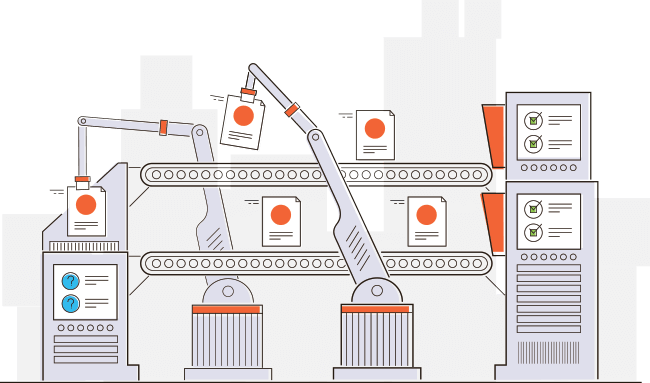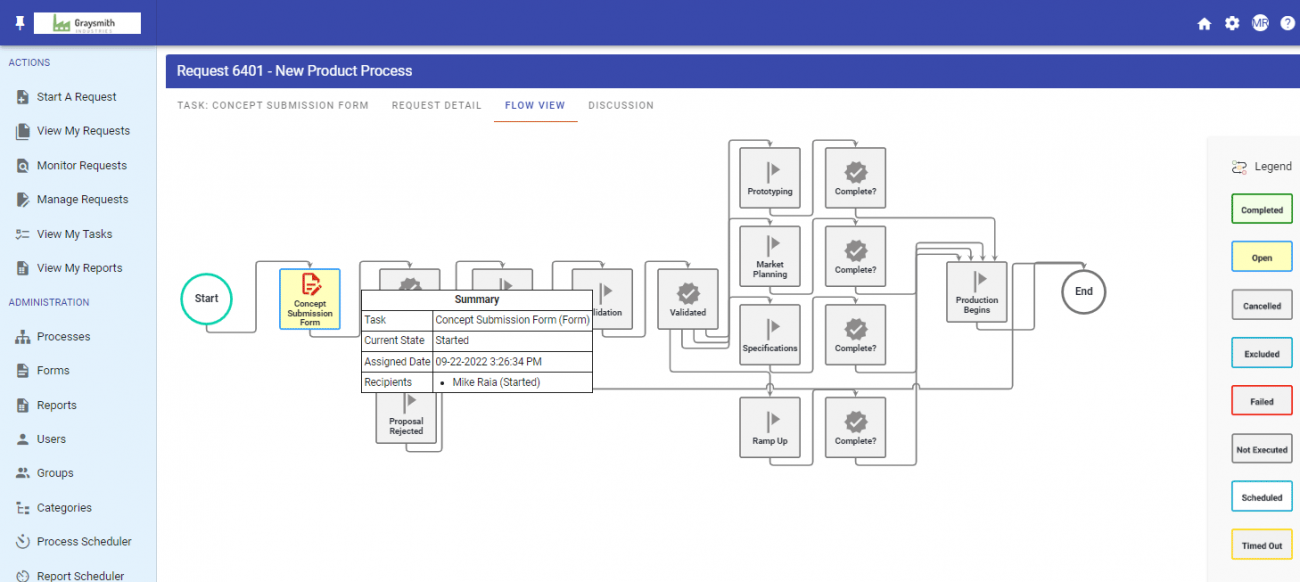Workflow Automation
Workflow automation improves productivity, efficiency, and customer experience.

Workflow Automation Definition
Workflow Automation refers to the design, execution, and automation of processes based on workflow rules where human tasks, data, or files are routed between people or systems based on pre-defined business rules. Using enterprise workflow software, your business can save time and reduce errors with automation.
Why Workflow Automation Is Used
By automating workflows, especially those processes that are primarily handled manually by employees, significant improvements can be made in:
- Efficiency
- Productivity
- Accuracy
- Audibility
- Accountability
- Job Satisfaction
How to Build an Automated Workflow Using Workflow Automation Software
Enterprise workflow automation doesn’t have to be complicated. Automated workflows can be designed visually to simulate or improve existing processes using a drag-and-drop interface to add and arrange tasks. In most cases, the process is illustrated in a static format and reviewed by all stakeholders for accuracy. Once the static design is finalized, work begins designing the automated process, including forms, tasks, recipients, alerts/notifications, etc. This is done using workflow automation software that includes pre-built tasks that can be arranged and connected.

Workflow automation software allows business users to design custom automated workflows. (Click for Larger)
Business Workflow Automation Examples
Here are some examples of processes that can benefit from optimization using workflow automation software:
| IT/IS
New Account Setup Finance Expense Approvals Salary/Wage Changes Marketing Campaign Approvals Brand Management |
Facilities
Office Relocations Resource Scheduling Facility Access Move Requests Sales Quote Approvals Pricing Discounts Proposal Approvals Product Discounts Legal Legal Holds |
HR
Benefits Changes Vacation Requests Purchasing Product Pricing Operations Maintenance Request New Product Request |
Simple or Complex, Your Workflows Can Be Automated
While there are usually human elements to any process, for instance, reviewing a document and providing approval, any workflow can be automated. Ultimately every workflow is just a series of tasks that must be performed.
Workflow Task Examples
- Pulling data from a system and preparing it for use
- Providing an answer (yes, no, data point, file attachment, etc.)
- Notifying someone to take an action
- Pushing data into a system (CRM, HRIS, ERP, etc.)
- Assigning an action to someone
- Importing data from a file like Excel
- Completing a form either manually or through RPA
Automating a given workflow process can involve a straightforward request/approval process or several workflow tasks and resources triggered by business rules. For instance, an employee may request the approval of capital expenditures by completing an online form.
This triggers workflow automation that routes the employee's request to their supervisor for approval. If the supervisor approves, the request is then routed to a different area of finance based on the amount of the request (e.g., Under $25,000 is routed to a Finance Manager, while over $25,000 is routed directly to the CFO). Once the appropriate Finance approver approves the request, it may be routed to the relevant purchasing agent based on the type of request (IT purchase, Marketing purchase, Event purchase, etc.)
Example of Automation: Automating Capital Expenditure Request Workflow
All the steps and actions in the workflow process are tracked and reported in real time for long-term trend analysis. For instance, department managers can report on service levels and identify weak points or bottlenecks. In addition, requestors have visibility into request status for better planning. As needed, information regarding the request can be automatically transferred into ERP, CRM, and other business systems.
Workflow automation provides several benefits over manual processes:
- Policy compliance adherence
- Reduced approval cycles
- Reduced manual handling
- Improved communication
- Improved visibility
- Improved employee satisfaction
- Continual process improvement
- Better workload management
- Reduced errors
Workflow Automation systems provide administrative users an environment for creating and editing workflow automation schemes, usually through a visual/drag-and-drop interface. Shapes and connectors represent the people and tasks to be performed for any given request so that an automation scheme can be built based on real-world activities. This allows for rapid prototyping of workflows in an easily understood schema. Once deployed, administrators can use workflow analysis tools like reporting, dashboards, and KPIs to ensure processes are running as smoothly as possible.
Workflow Automation Vendors
Companies like Kissflow, Worktec, Flokzu, etc., provide simple workflow tools for small businesses, while Integrify provides robust tools for mid-size and enterprise companies. SMB and Enterprise workflow software differ in feature set, interoperability, scalability, and service/implementation component. Other tools like Lotus Workflow and Sharepoint Workflow are being sunset, so their parent company can focus on other core features.
Frequently Asked Questions
Do I have to be a developer to use workflow automation?
No. These tools are designed for business users with drag-and-drop methods for creating forms and processes. Developers can use additional tools to extend the system if desired.
What is the cost of workflow automation systems?
Pricing approaches vary among vendors; however, most cloud-based systems use a per-user subscription method where your cost is based on the number of users accessing the system.
What are workflow automation tools?
Workflow automation tools are used to standardize and automate forms and processes and pass data between systems—more on workflow tools here.
What is data workflow automation?
Data workflow automation refers to the structured movement of data between systems.
What is workflow automation in CRM?
Most CRM tools have some level of workflow automation built-in. It usually involves triggering a workflow related to a data update, integration, timed action, etc. These tools are specific to the CRM system, requiring users to have CRM licenses. When you use workflow automation, your CRM can be even more effective.
Interested in Automating Your Workflow?
We have a library of resources to help you on your journey to an automated workplace.


